Inside: Check out 25 simple and creative sloped backyard landscaping ideas to give your yard a fresh look, without breaking the bank. You can make your outdoor space both beautiful and practical.
If you’ve got a sloped backyard, you probably know how tricky it is to design and actually use it. These ideas can help you turn that uneven ground into a spot where you’ll want to hang out and unwind.
You’ll see some easy ways to work with your slope, not against it, making your backyard feel more inviting and fun.

1. Build a tiered retaining wall to create flat planting areas
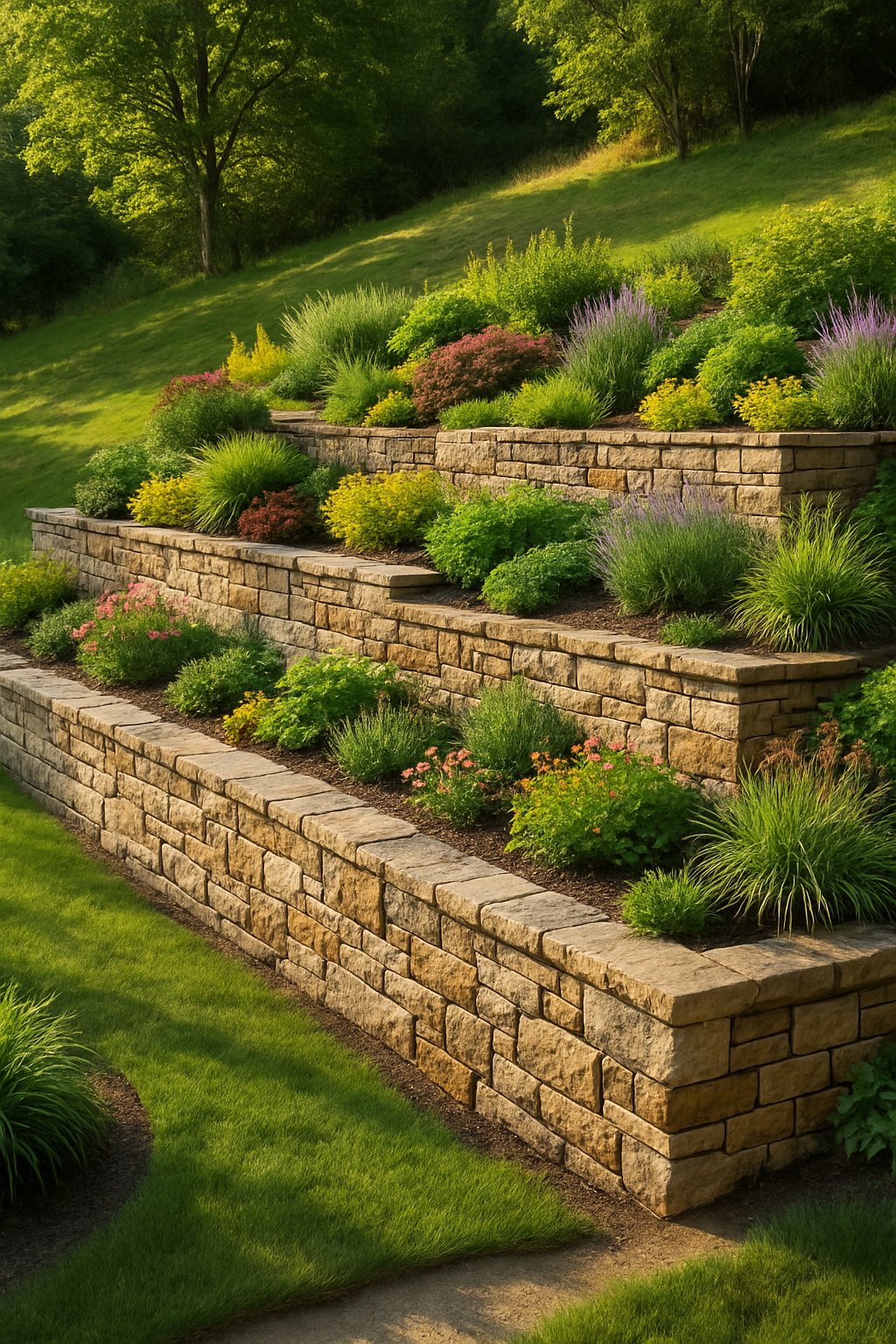
When your backyard slopes, you can build a tiered retaining wall to carve out flat spots for planting or relaxing. These walls hold back soil and create level terraces or steps.
Pick from stone, wood, or concrete blocks depending on your taste and budget. Flat areas like this help prevent soil erosion and make gardening a whole lot easier.
You get to mix up plants on each tier, playing with colors and textures. It really adds some interest to your yard.
Check that each tier stays stable and drains well, so you don’t get water pooling behind the wall. If you add a patio or seating area on one level, suddenly your slope becomes a spot you’ll actually use.
Expert Tip from MrPlanter: “Use strong materials and make sure you have good drainage behind your retaining walls. That way, they last longer and your plants stay healthy.”
2. Install a multi-level wooden deck

A multi-level wooden deck can totally change a sloped backyard. It gives you flat spaces where you can relax or entertain.
You might want to build different levels for seating, eating, or even gardening. Start by figuring out how many levels you want and where each one should go.
Use sturdy, weather-resistant materials so your deck lasts through all kinds of weather. Connecting the levels with stairs or ramps keeps everything easy to reach.
This kind of deck follows the slope, so you won’t need to dig much or build tons of retaining walls. It also makes your yard more interesting and gives you more usable space.
Don’t forget to check if you need permits. Good drainage and strong framing are a must for safety.
Expert Tip from MrPlanter: “Go for natural wood that matches the landscape for a smooth look. Try wider steps—they can double as extra seating or spots to show off your plants.”
3. Create a rock garden with native stones

If you use native stones in your sloped backyard, you’ll get a natural look that fits right in with the environment. Local stones are easy to find and just seem to work with the plants.
Arrange rocks to make terraces or small walls that help keep the slope in check. Tuck in some succulents, grasses, or small shrubs between the stones—these plants don’t need much water and look great growing out of little cracks.
Rock gardens also help water drain and stop soil from washing away when it rains. Try using different sizes of stones for more interest.
Put the bigger rocks at the bottom and smaller ones up higher. This layering keeps things balanced and stable.
Expert Tip from MrPlanter: “Pick stones that match your local soil’s color and texture for a seamless look. Give your plants enough space to grow so they don’t get crowded.”
4. Plant colorful perennials along the slope
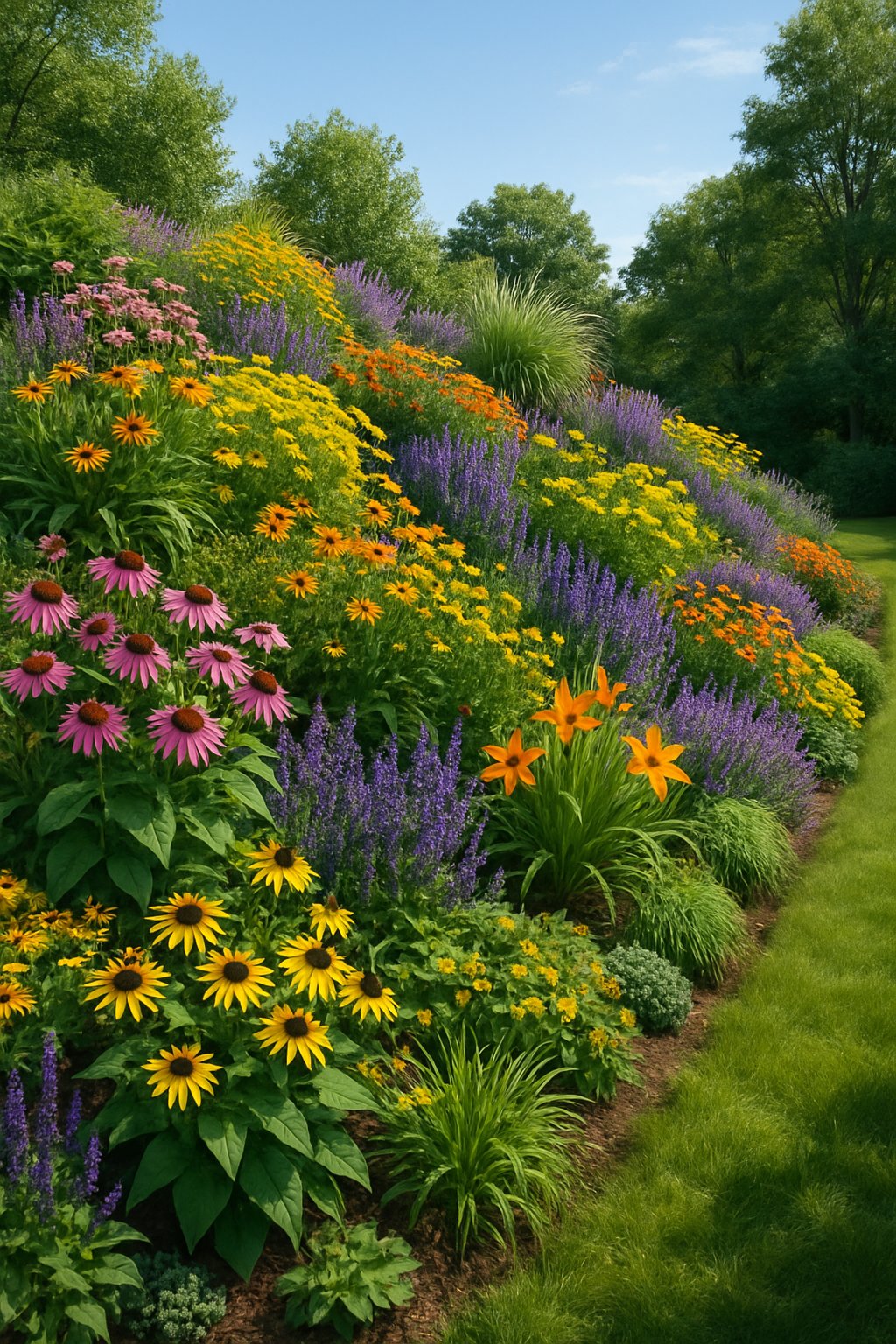
Brighten up your slope with colorful perennials that help control erosion. Their deep roots hold soil together and the flowers give your yard a pop of color.
Pick perennials that can take sun and dry conditions—think coneflowers or black-eyed Susans. These plants don’t need much water and thrive on slopes.
Plant them in groups for a fuller look and better erosion control. Other tough choices like daylilies or lavender bloom for a long time, so you’ll get color for months.
Give your plants enough room to spread as they grow. Crowding them just makes things harder down the road.
Expert Tip from MrPlanter: “Choose perennials with different bloom times so you always have color. Group plants with similar water needs to simplify care.”
5. Add low retaining walls for plant beds
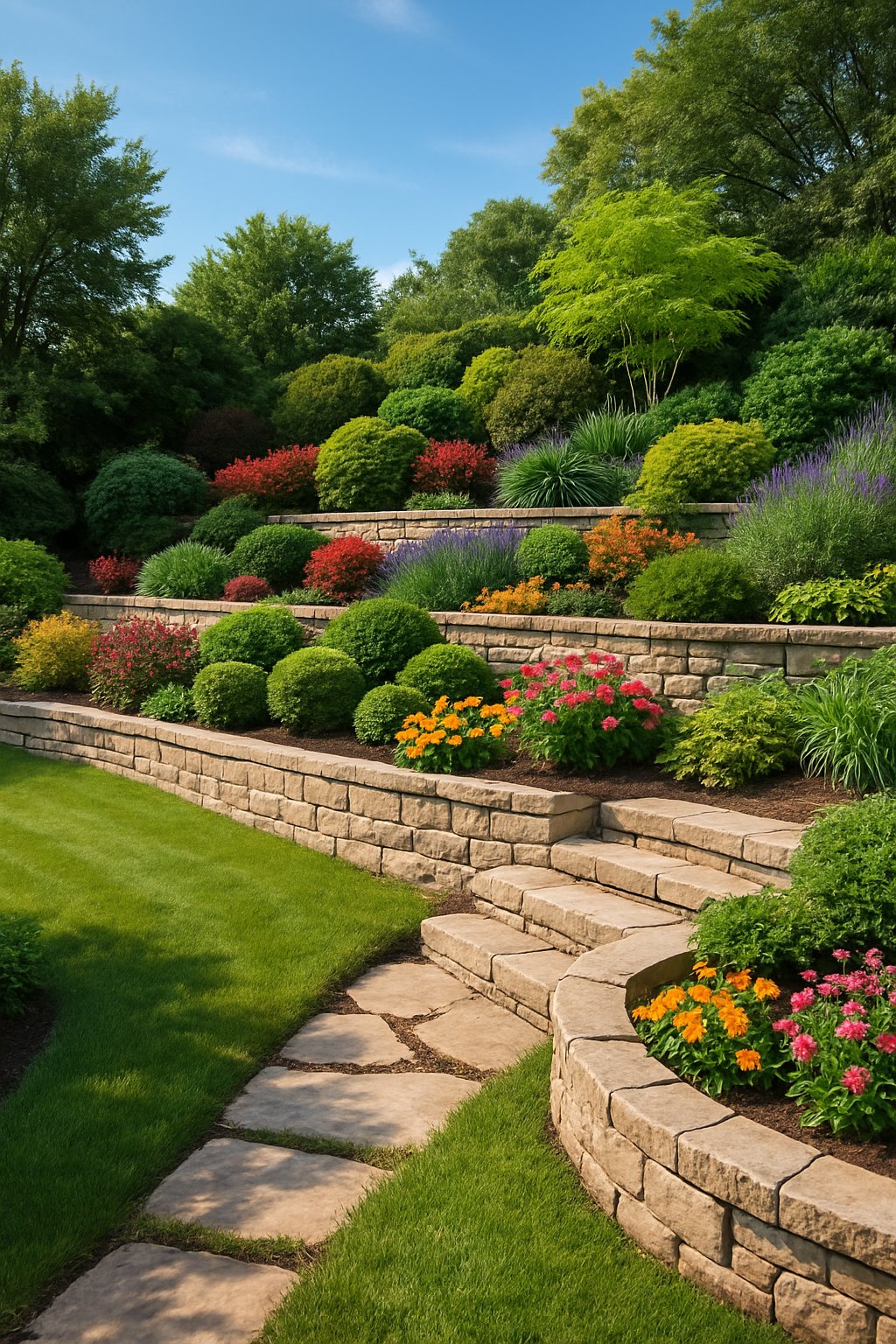
Low retaining walls let you carve out level spots on a slope. They hold soil in place and make planting much easier.
You can use stone, wood, or concrete blocks—just pick something that fits your yard’s style. These walls add structure and make your plants stand out.
Try separating flower beds or veggie patches with them. Retaining walls also slow water down, which protects your plants from erosion.
Keep the walls on the low side so they don’t block your view or make the yard feel crowded. Sturdy but subtle is the goal.
If the wall’s wide enough, you can add seating on top. It’s a nice way to mix function and looks.
Expert Tip from MrPlanter: “Use untreated cedar or stone for a natural, long-lasting look. Put drainage gravel behind the wall to stop water damage.”
6. Use groundcover plants to prevent erosion
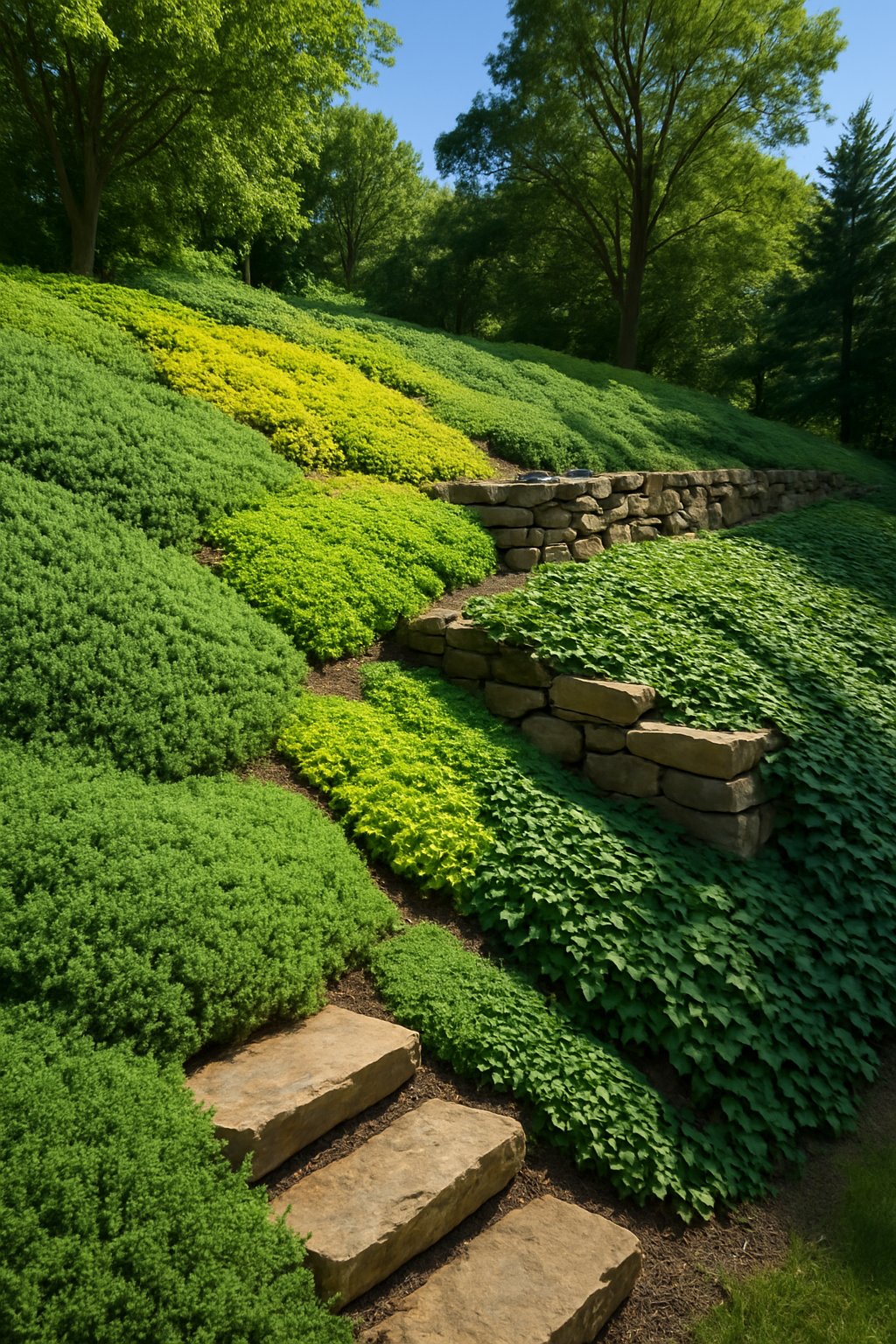
Groundcover plants work wonders on slopes because their roots lock soil in place. They cut down on runoff and keep dirt from washing away after rain.
Try low growers like creeping juniper, blue rug juniper, or creeping phlox. These spread out and make a thick green blanket over the ground.
Some, like low sumac, have dense stems that are perfect for steep hills. Others, like vinca minor or pachysandra, do great in shady spots.
Groundcovers help you avoid bare patches that lead to erosion. Once they’re established, most don’t need much care.
Expert Tip from MrPlanter: “Pick plants that match your slope’s sun or shade. Water them well at first until roots get strong.”
7. Terrace the slope with stone or wood steps

Breaking up a steep slope with stone or wood steps creates flat, usable areas. You’ll find it much easier to walk on and it looks great too.
Use natural stone for a rustic vibe or go with wood if you want something warm and inviting. Terraces also help slow water down, fighting erosion.
Plant flowers, shrubs, or veggies on each level if you like. Steps between terraces make it safer and more comfortable to get around.
Choose tough materials that can handle the weather. Keep step heights consistent to avoid tripping.
Add some lights along the steps for safety and a bit of nighttime charm.
Expert Tip from MrPlanter: “Tamp down the soil behind each terrace to stop shifting. Use gravel under steps for drainage and longer life.”
8. Install a floating deck backing into the hillside

A floating deck gives you usable space without tons of digging. Build it on posts so it “floats” above the slope.
Backing it into the hillside creates a cozy, tucked-away spot. The slope acts as a wall, giving you privacy and blocking wind.
You can blend the deck with retaining walls or plants to make it feel like it belongs there. Since it’s raised, it won’t mess up the hill’s drainage.
It’s easier to build and tweak than decks with deep foundations. Use weatherproof wood like cedar or composite for durability.
Make sure to space support posts right so the deck stays strong. Stairs down the hillside connect the deck to your yard for easy access.
A floating deck can make a sloped yard way more functional and inviting.
Expert Tip from MrPlanter: “Anchor the deck well into the hillside so it won’t shift. Always check local codes for slope and deck height rules before you start.”
9. Plant a mix of shrubs and small trees

Mixing shrubs and small trees helps keep your slope in place. Their roots hold the soil, making things more stable.
Try different heights and textures for extra interest. Tall trees can give shade, while shrubs fill in the blanks and add color.
Choose plants that fit your climate and soil. Evergreens give year-round coverage, and flowering shrubs add seasonal flair.
Plant in groups instead of rows for a more natural look. Put some near walkways or seating spots to make things feel cozier.
Expert Tip from MrPlanter: “Start with native plants—they need less water and care. Group similar plants to make upkeep simpler.”
10. Create winding grassy paths to break up the hill
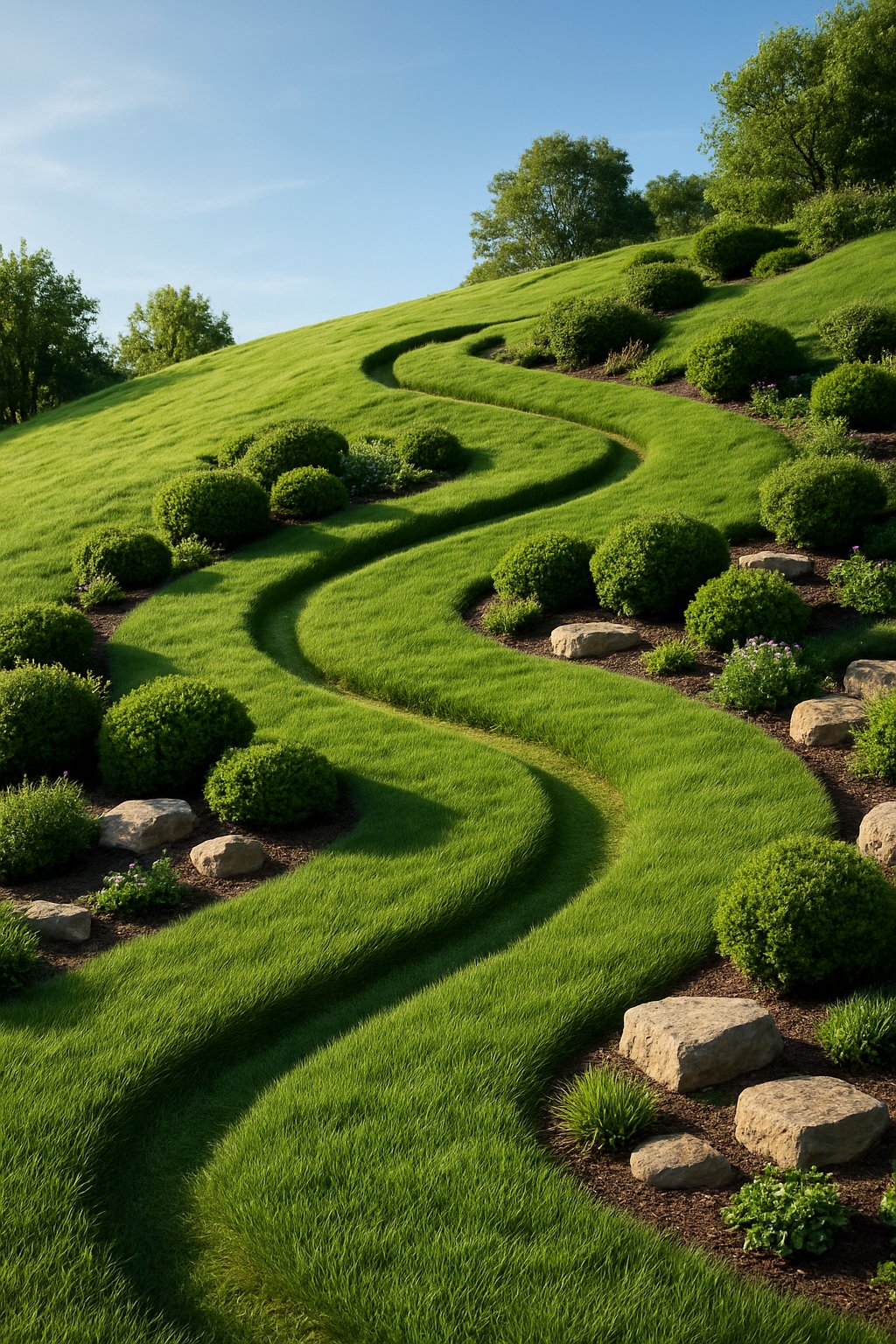
Winding grassy paths soften the look of a steep yard. They add a natural touch and give you a safe way to get up and down.
Curve the paths around your yard to break the slope into smaller, easier-to-manage sections. This also gives you spots for plants or cozy seating areas along the way.
Grass paths are pretty easy to keep up and help stop erosion by holding the soil. Choose grass that can handle some foot traffic, like tall fescue or Bermuda.
Add edging with stone or wood to keep the path tidy. It’ll also stop soil from washing onto the path during rain.
Expert Tip from MrPlanter: “Make paths wide enough for easy walking and plant low growers on the edges for extra texture. Curves just feel right in sloped spaces.”
11. Add a calming water feature like a small waterfall
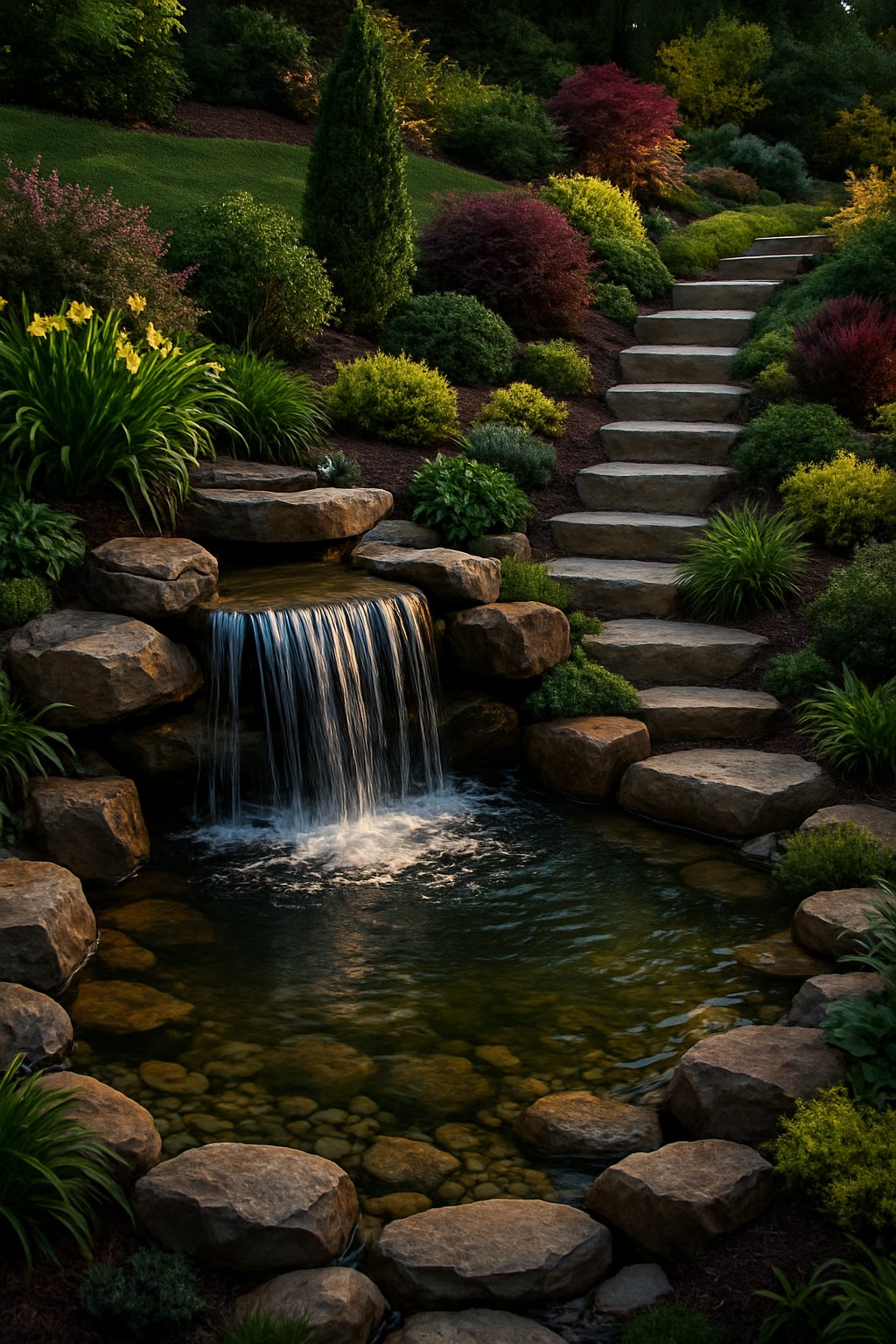
A small waterfall really shines in a sloped backyard. The natural drop in your yard makes it easy to let water flow down, adding movement and that peaceful sound everyone loves.
Try placing your waterfall along a rocky slope or tucked near some plants. It feels way more natural that way, almost like it belongs there.
Water features do a great job hiding noise from the street or neighbors. Even a compact waterfall can totally change the vibe in a small space.
Go with stone or wood if you want your water feature to blend in with your yard’s style. There’s no need for a huge pond—just a little basin at the bottom will do.
Add a pump to keep the water flowing. That makes maintenance way easier, trust me.
Expert Tip from MrPlanter: “Make sure your pump size matches the height of your waterfall for steady flow. Add native plants around it to support local wildlife and improve the look.”
12. Use native plants that thrive on slopes
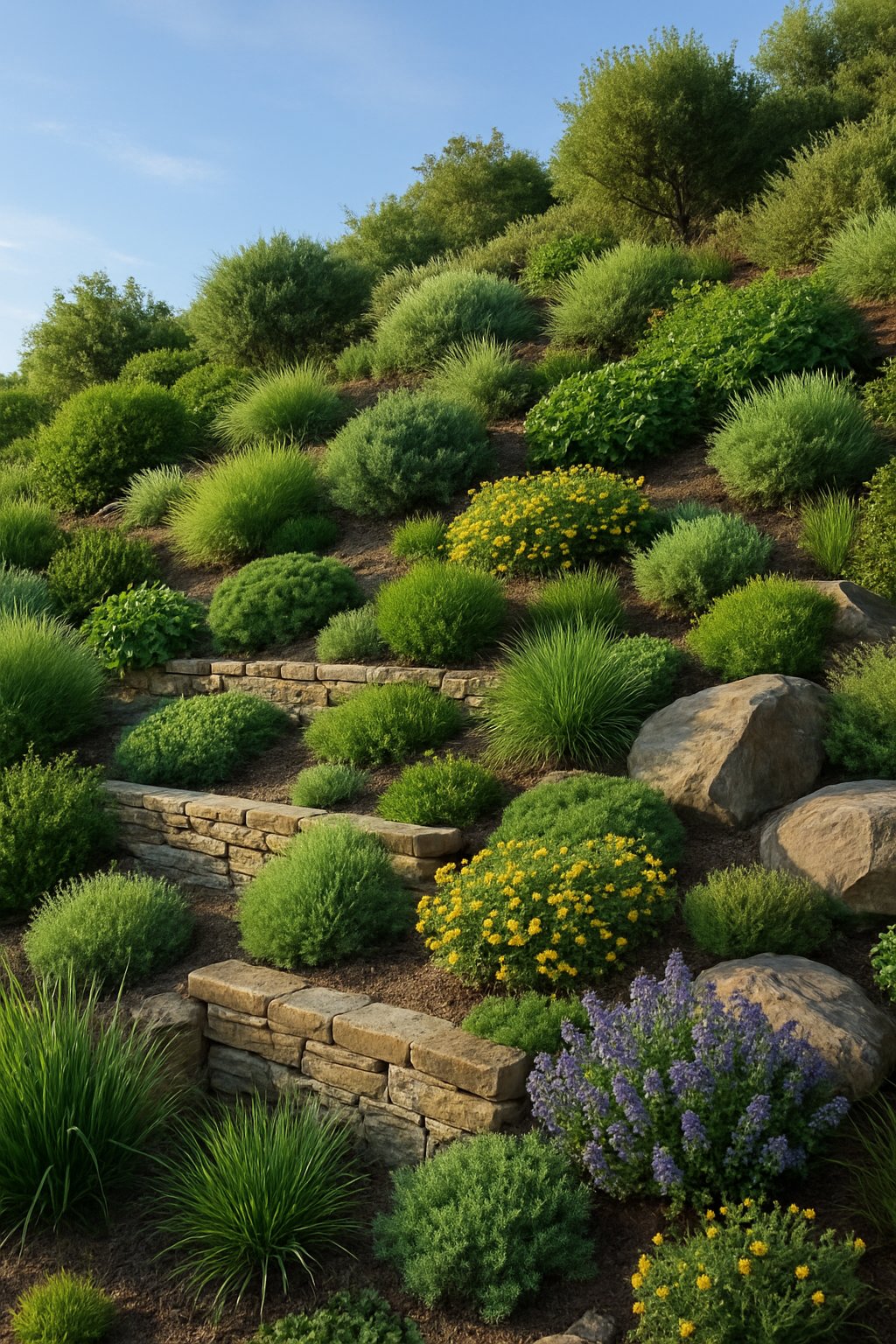
Native plants just get sloped yards. They’re already built for your local weather and soil, so you’ll spend less time watering and worrying.
This means you save time and money—who doesn’t want that?
Try drought-tolerant shrubs like toyons or manzanitas. These help keep soil in place and cut down on erosion.
Add some grasses and flowers like black-eyed Susans or mountain mint for extra color and texture. Native plants usually thrive in those dry, sunny spots you find on slopes.
They also attract bees, butterflies, and other local wildlife. If you mix different native plants, your yard gets that wild, strong look.
Expert Tip from MrPlanter: “Plant native shrubs in groups to quickly cover bare soil and stop erosion. Use mulch around plants to keep moisture in and reduce weeds.”
13. Build raised vegetable garden beds on terraces
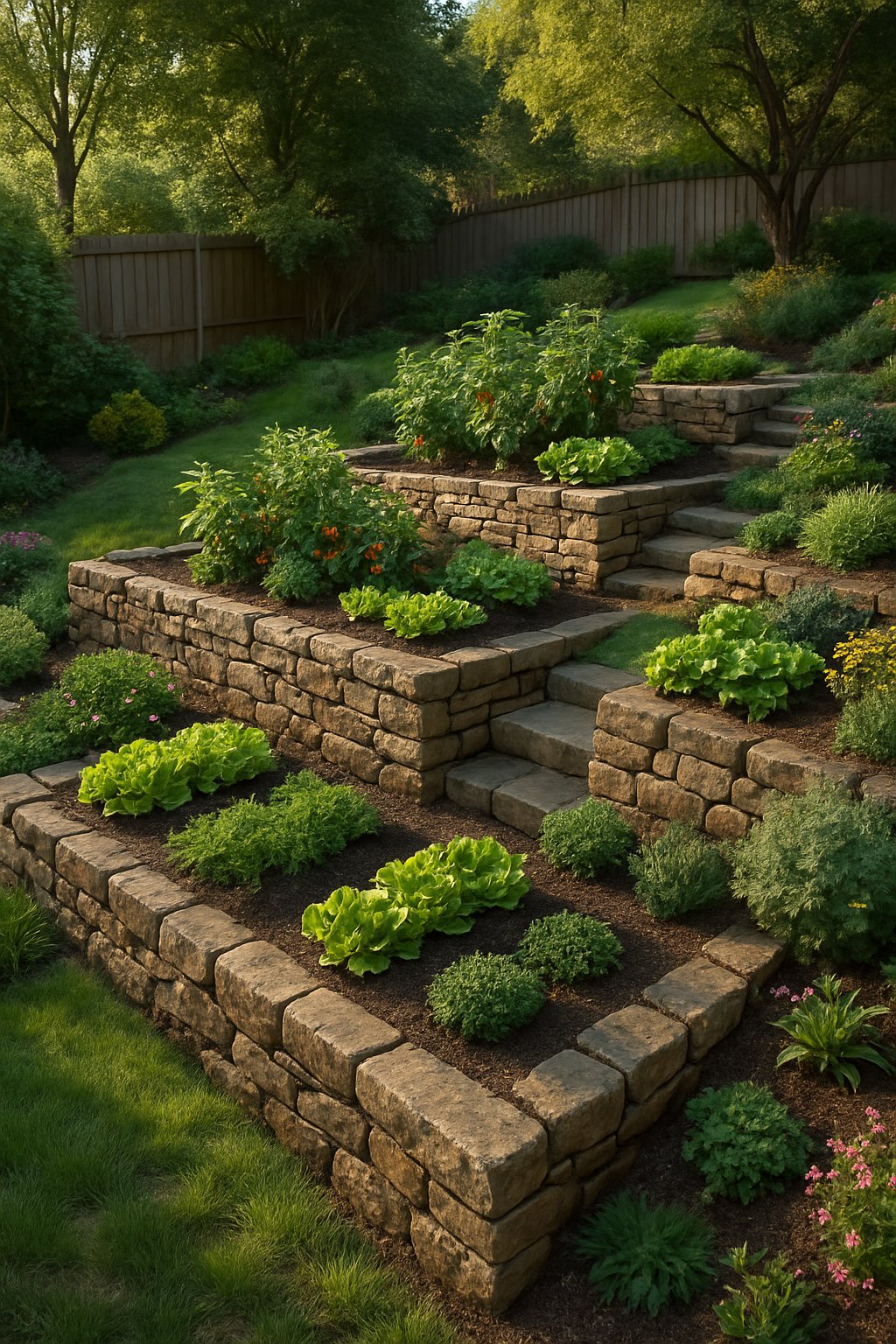
When you terrace your sloped backyard, you get flat spots for raised vegetable beds. These beds make planting way easier and help stop soil from washing away.
Use wood, stone, or whatever sturdy material you like for the walls. Each terrace acts like a mini garden, so your plants have a stable place to grow.
Raised beds drain better, which is a big deal on slopes. They also help slow down water runoff, so your plants actually get the moisture they need.
Terracing helps you organize your garden. You can plant different veggies on each level and swap them around each season.
Building terraces means you get more usable space without a ton of extra yard work.
Expert Tip from MrPlanter: “Use sturdy materials like treated wood or stone for terrace walls to last through weather changes. Add compost to your raised beds to improve soil and help your vegetables thrive.”
14. Incorporate large boulders as natural focal points

Try using large boulders to create bold, natural focal points in your sloped backyard. Place a boulder (or a few) where they’ll stand out—maybe near your seating area or right by a garden bed.
Plant some colorful flowers and greenery around the boulders to soften them up and make things pop. If you bury the boulders halfway, they look way more natural and solid.
Flat boulders can double as steps if you want a rustic path up your slope. Just don’t crowd them—give each boulder some space for balance.
Natural stone goes with pretty much any plant or landscaping style. Mixing up the sizes gives your yard more depth and keeps things interesting.
Expert Tip from MrPlanter: “Bury your boulders more than halfway to give a natural, grounded look. Always add plants and flowers around them to soften the hard edges.”
15. Plant a flowering hillside garden
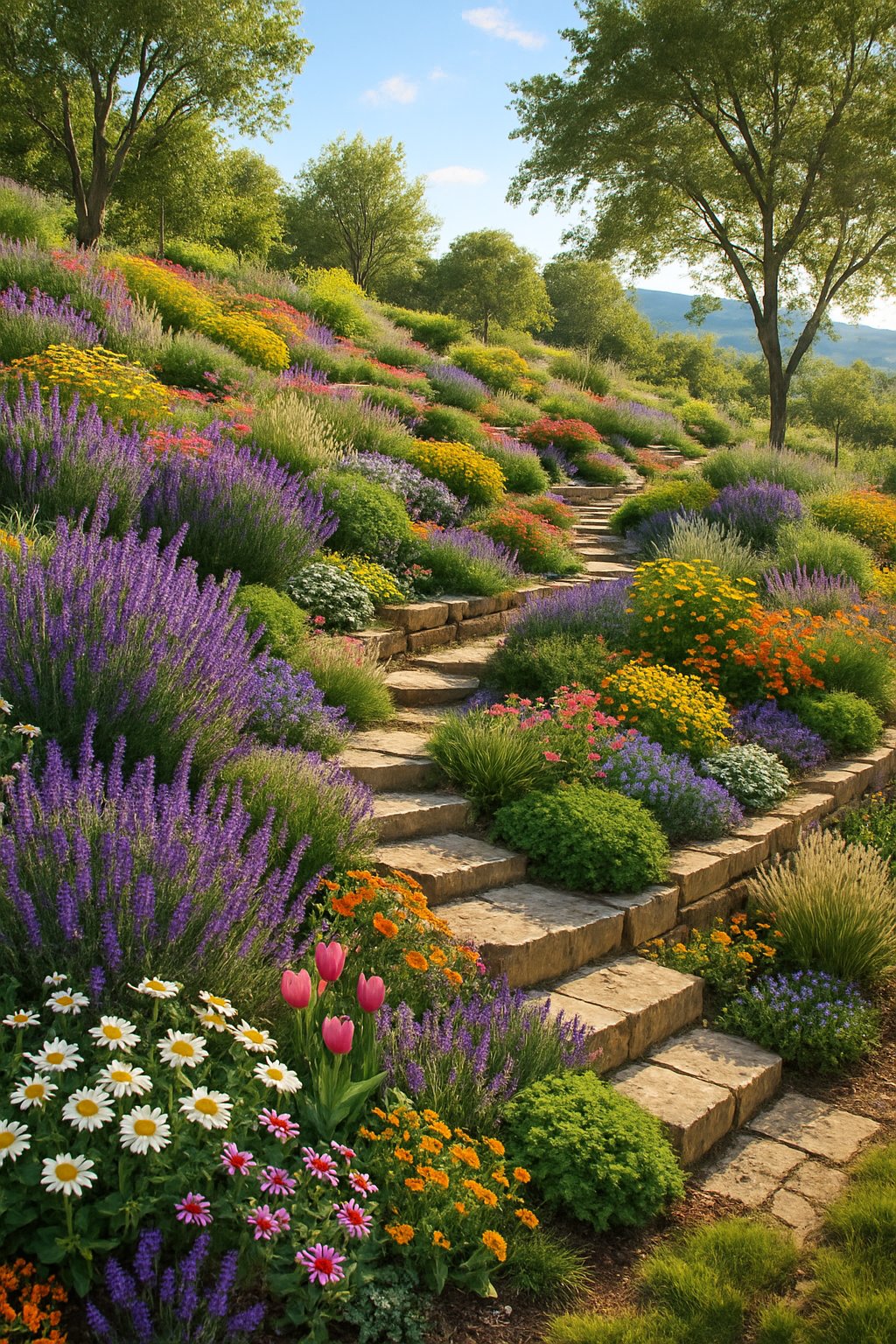
Planting flowers on a slope brings in color and helps keep soil from sliding away. Pick flowers with strong roots, like creeping phlox, sedum, or lavender.
Mixing up your flower choices gives you a more natural, lively look. Make sure to choose flowers that can handle sun and wind—slopes usually get plenty of both.
Adding mulch around your plants keeps moisture in and protects the roots. You can plant in terraces or little pockets on the slope to make things easier and stop water from running off.
Keep up with watering until your plants get settled in.
Expert Tip from MrPlanter: “Start with native flowers as they adapt best to your hillside. Group plants with similar water needs to simplify care.”
16. Create a cascading garden with tiered planters
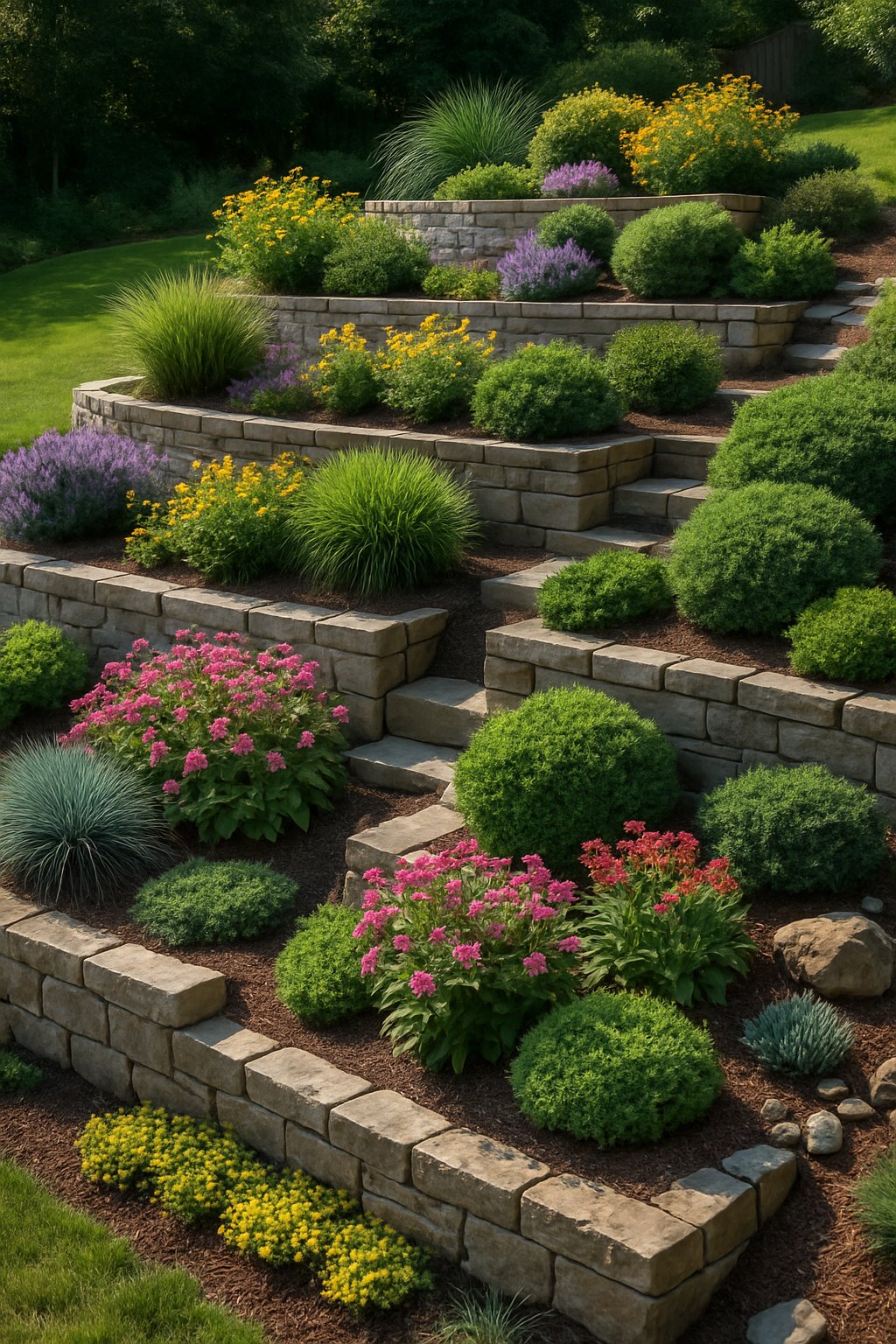
Tiered planters are a clever way to add height and depth to your sloped backyard. Stack pots or build levels for a cascading effect that fits almost any space.
This setup lets you grow more plants without hogging all your ground area. It also makes watering and care easier, since your plants are grouped together.
Pick plants that fit each level’s sun and water needs. Flowers, herbs, succulents—mix them up for more color and texture.
You can make tiered planters from wood, metal, or stone. Just pick something that matches your backyard style and can handle the weather.
A cascading garden turns a tricky slope into a garden feature you’ll actually want to show off.
Expert Tip from MrPlanter: “Use lightweight pots for the top tiers to avoid putting too much weight on the bottom. Make sure each planter has proper drainage to keep roots healthy.”
17. Install garden lighting along stairways
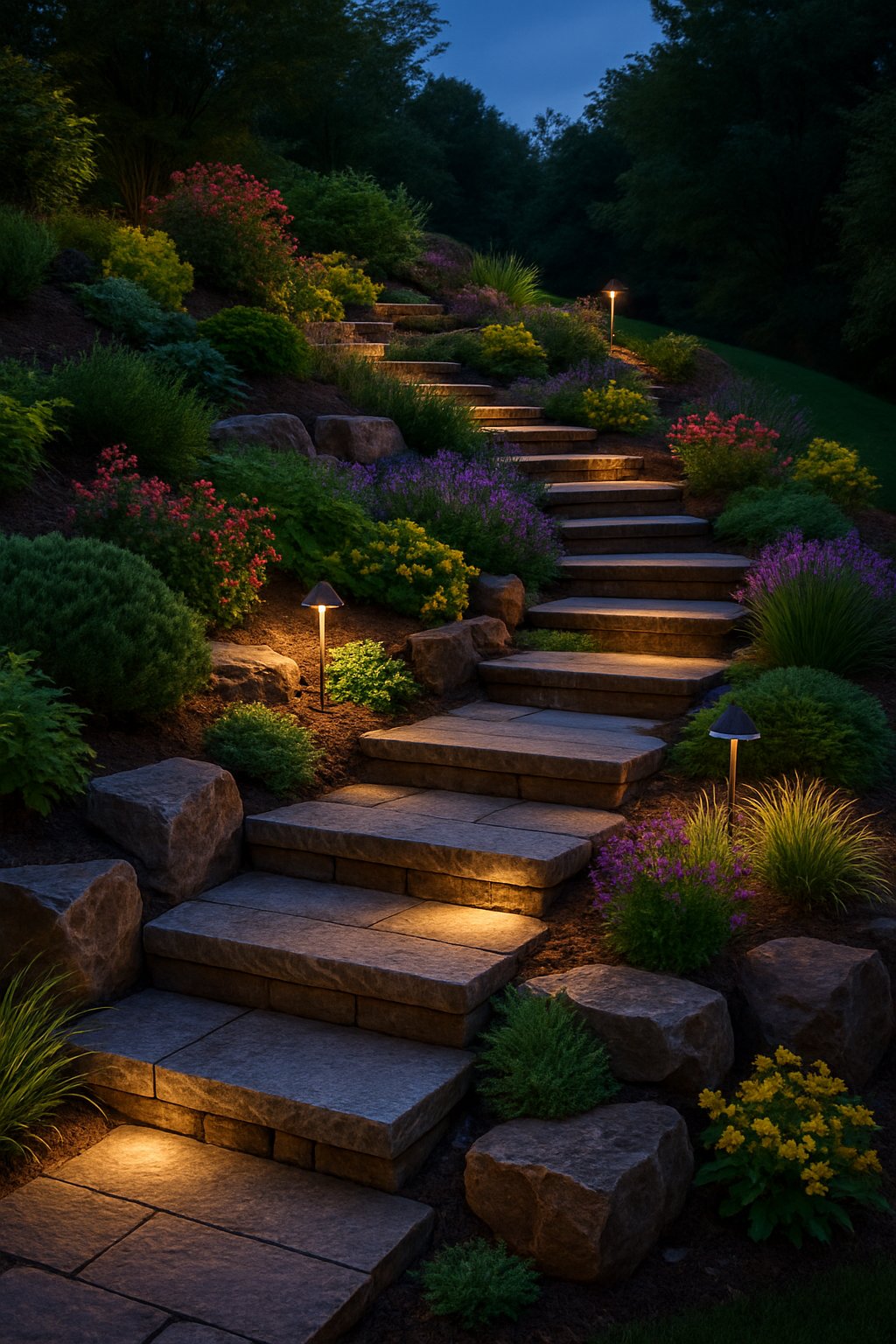
Add garden lighting to your backyard stairways for a safer, more inviting space at night. You’ll see each step clearly, so it’s way less likely you’ll trip or miss a step.
Go for small LED lights or solar-powered fixtures—they’re easy to put in and don’t need extra wiring. Place lights on the sides or under the stair treads for a nice, subtle glow.
Besides safety, lighting makes your backyard look warm and welcoming. It also highlights your stairs’ design, making them stand out after dark.
Make sure you use waterproof, weather-resistant lights so they last. You can adjust the brightness to avoid harsh glare.
Expert Tip from MrPlanter: “Use solar lights for easy setup and eco-friendly lighting along your stairs. Position them at even intervals to keep the path well-lit and attractive.”
18. Mix evergreens with seasonal bloomers
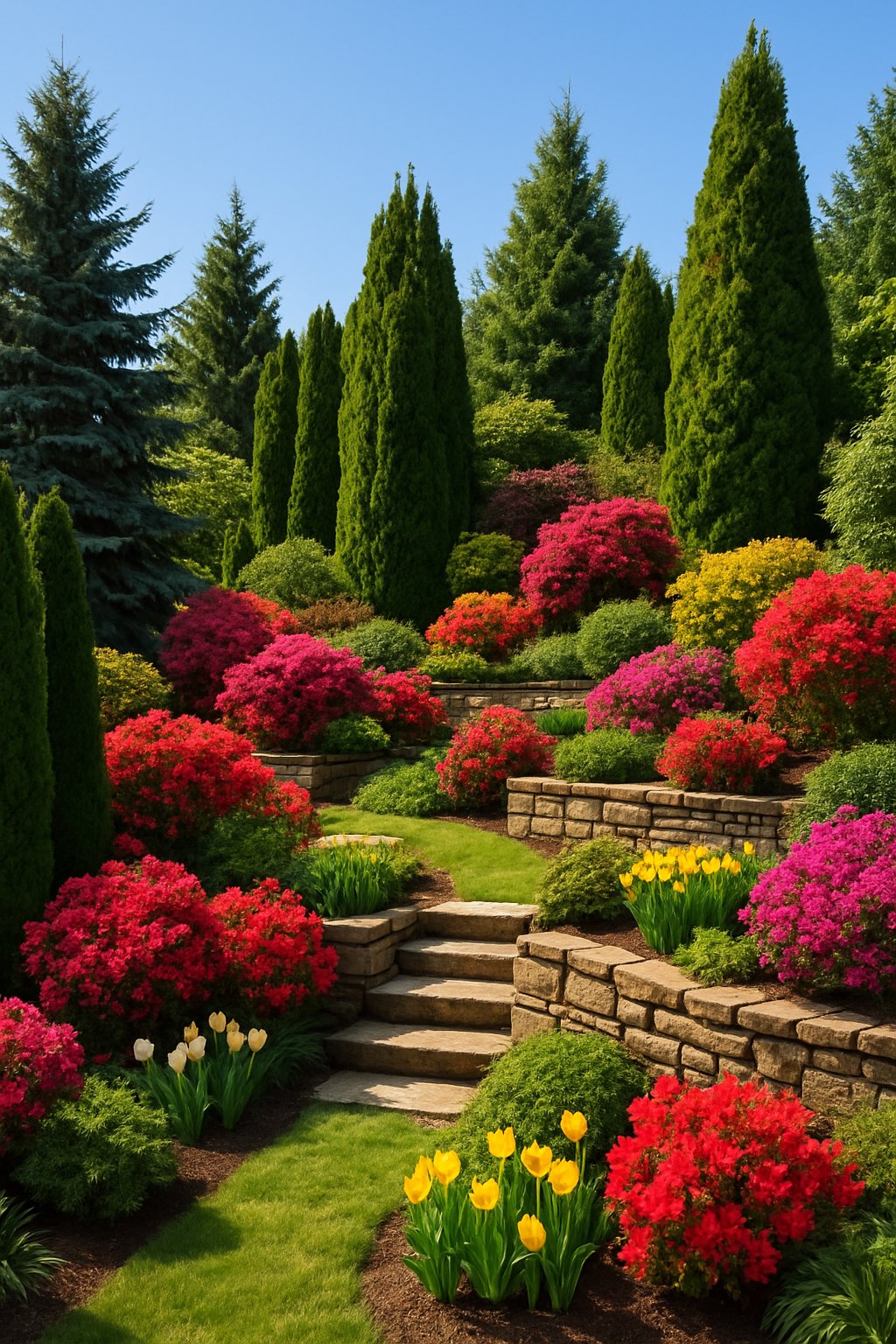
Evergreens keep your sloped backyard looking lively all year. They give structure and steady color, while seasonal flowers add pops of color that change through the year.
Pick small evergreen shrubs for easy planting on slopes. Then, add bloomers like tulips in spring or mums in fall for extra interest.
Place evergreens where you worry about soil erosion. Plant seasonal flowers nearby for bursts of color you can swap out as the seasons change.
This mix keeps your slope stable and, honestly, just more fun to look at.
Expert Tip from MrPlanter: “Use drip irrigation to keep both evergreens and bloomers well watered on slopes. It saves water and helps your plants thrive.”
19. Use mulch heavily to retain soil moisture

Mulch is seriously one of the best tricks for keeping soil moist on a slope. It blocks water evaporation and holds onto moisture for your plants.
Try wood chips for trees and straw for vegetables—they both work great. Mulch also slows down water runoff, so less soil washes away when it rains.
It keeps plant roots cooler and stops soil from drying out too fast. If your slope is steep, put down branches or barriers first to keep the mulch from sliding away.
Adding compost under your mulch can help soil hold even more water. It boosts soil health and helps your plants grow better.
Mulch also keeps soil from getting packed down, so water soaks in more easily.
Expert Tip from MrPlanter: “Use thick layers of mulch, about 3-4 inches deep, for best moisture retention. Keep mulch away from plant stems to avoid rot.”
20. Add benches on flat platforms for seating areas
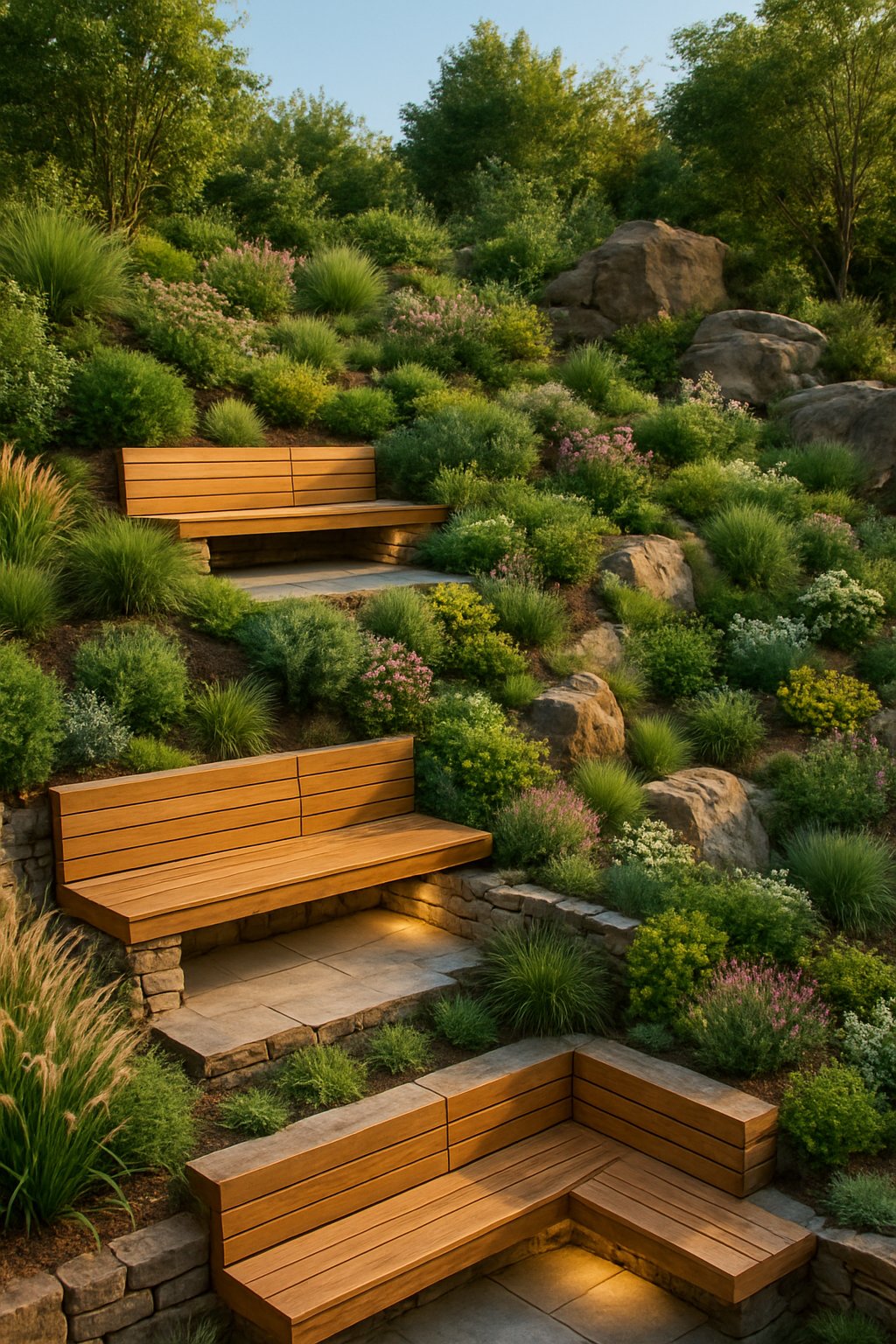
Build flat platforms on your slope for perfect bench spots. These level areas give you a safe, comfy place to sit—no one likes sitting on a tilt.
Use wood, stone, or concrete for the platforms. Mixing materials adds some variety to your yard and makes the seating areas feel intentional.
Placing benches on flat spots lets you enjoy the view. It also breaks up the slope, making your space feel a bit more organized.
Add plants or a small table nearby to make it cozy. This way, you create a nice place to relax on your own or with friends.
Be sure the platform is wide enough for the bench and for people to move around. That way, it won’t feel cramped.
Match the bench style to the look of your yard for a tidy, planned feel. If your slope is steep, try benches on different platforms as resting spots along the way.
Expert Tip from MrPlanter: “Use durable materials for your benches to withstand weather on a slope. Plant low-growth shrubs around platforms to keep soil stable and add natural beauty.”
21. Plant drought-resistant ground covers
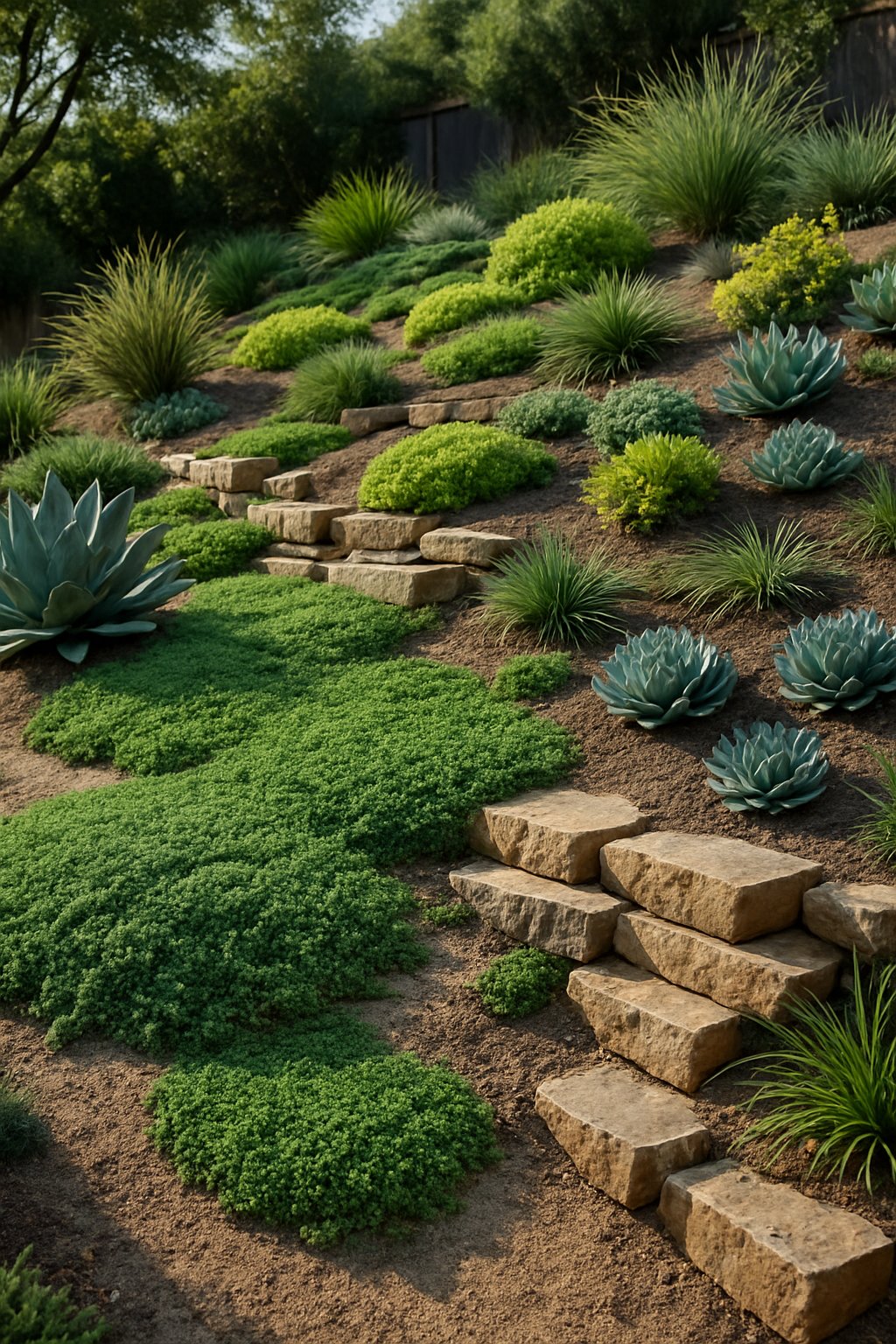
Drought-resistant ground covers are a lifesaver for saving water and stopping soil erosion on slopes. Once you get them established, they need barely any care.
Choose plants like stonecrop or native buckwheat for those sunny spots. These handle heat, drought, and even a little foot traffic.
Plants with gray or silver leaves, like lamb’s ear or lavender, reflect sunlight and stay healthy even when it’s hot. Using these ground covers gives you a green, low-maintenance hillside that looks good all year.
Pick the right types, and you’ll attract pollinators too.
Expert Tip from MrPlanter: “Start planting drought-resistant covers in groups to make a fuller look quickly. Water them weekly until their roots grow deep into the soil.”
22. Build stone steps with side flower beds

Stone steps bring a natural vibe to a sloped backyard. If you build them with care, you’ll get safe, sturdy paths to walk up or down the hill.
Pick out flat, solid stones for each step. That way, you keep the path level and easy to use.
Add flower beds on both sides of the steps to soften the harsh stone lines. It’s a simple way to bring in some color and charm.
Go for plants that handle slopes and don’t fuss much over maintenance. No one wants to spend all weekend weeding, right?
You can use rocks or bricks to border the beds. This trick keeps the soil from sliding away when it rains.
Fill the beds with a mix of flowers and maybe toss in a few small shrubs for some variety.
Check that your steps drain well, or you’ll end up with puddles and slippery stones. Nobody wants that.
Expert Tip from MrPlanter: “Use drought-tolerant plants to reduce water needs. Add mulch to your flower beds for better moisture control.”
23. Design a rock retaining wall with integrated seating
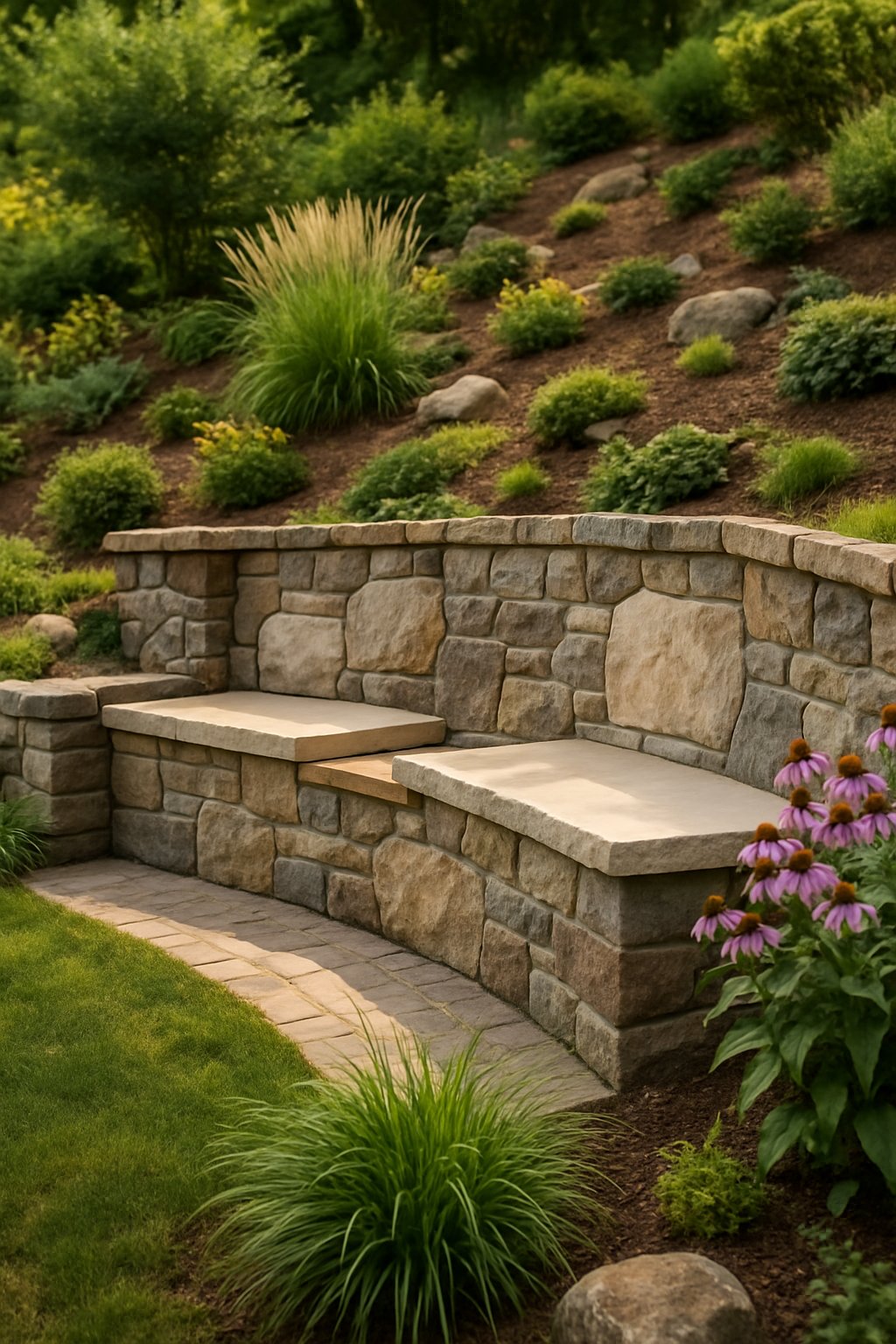
A rock retaining wall does more than just hold back your sloped yard. Try adding built-in seating and suddenly, you’ve got a spot for hanging out.
Pick flat, sturdy stones for the seats. They’ll feel comfortable and won’t wobble.
This design can save a lot of space by mixing structure with function. Let the seating curve along the wall for a relaxed, natural look.
Toss on some cushions or pillows if you want extra comfort or a pop of color.
Make sure your wall’s strong enough to handle people sitting on it. Use mortar or stack the stones carefully so nothing shifts.
Plant a few things nearby to soften the hard edges. It helps the wall blend right into your garden.
Integrated seating really creates a cozy spot for relaxing outdoors. Friends and family will probably love it, and it just makes your yard more interesting.
Expert Tip from MrPlanter: “Use weather-resistant cushions to keep your seating comfortable through all seasons. Always check for proper drainage behind your wall to avoid water damage.”
24. Create a natural habitat garden with native grasses

Planting native grasses in your sloped backyard helps keep soil where it belongs. These grasses already know how to handle your local weather, so they won’t need much water or fuss.
When you use native grasses, you create a safe spot for birds and insects. Plus, you get cool textures and gentle movement in your garden.
Group your grasses in small clusters to copy how they grow in the wild. It looks more balanced and helps keep the slope steady.
Mix tall and short grasses for extra depth. Native grasses often show off soft colors that shift with the seasons.
Pair them with other native plants if you want. You’ll end up with a low-maintenance, eco-friendly landscape that just fits in with nature.
Expert Tip from MrPlanter: “Start with just a few native grasses and watch how they spread naturally over time. This slow growth helps your slope stay strong and beautiful.”
25. Add climbing plants on trellises against retaining walls
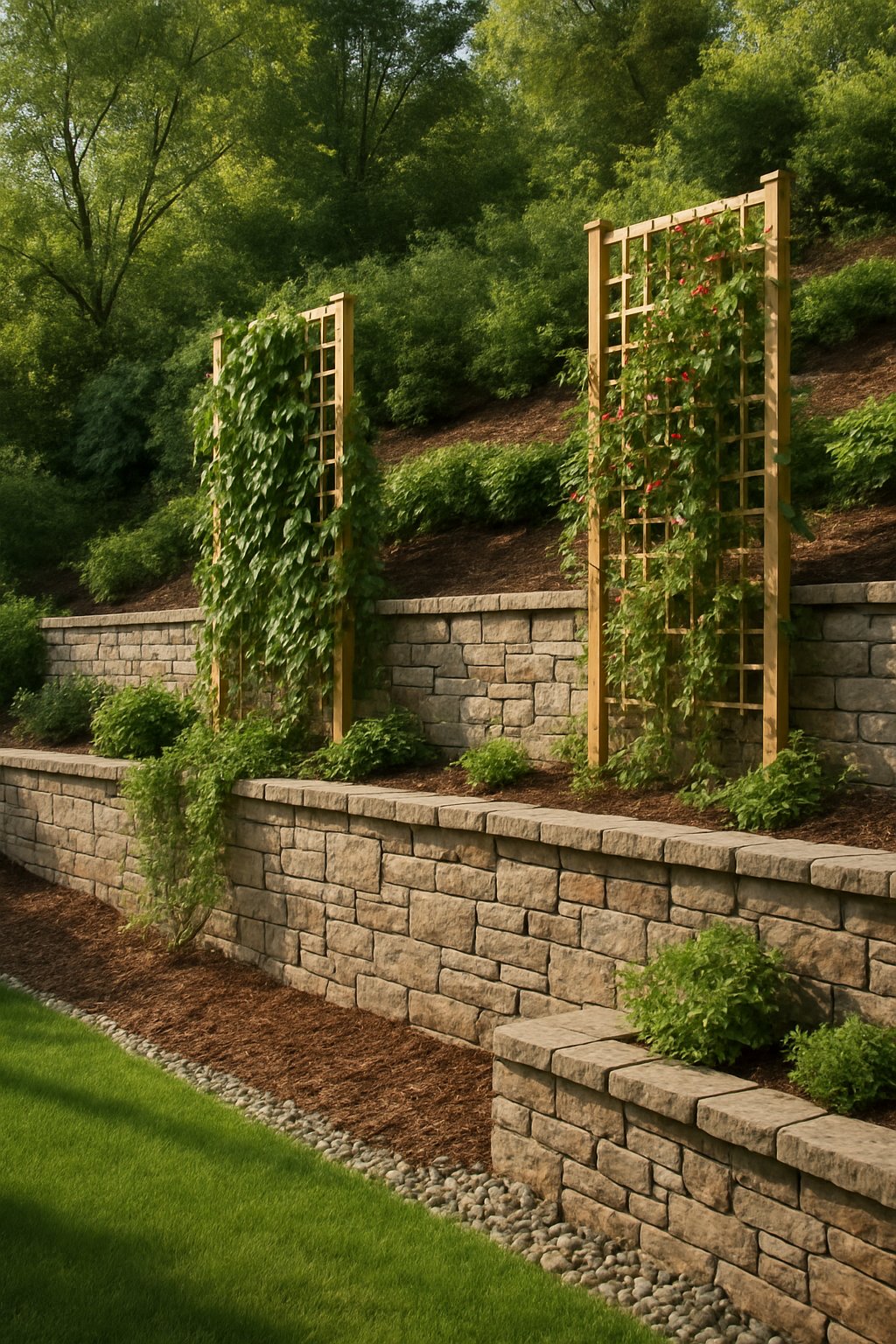
Climbing plants on trellises can really soften up the look of a retaining wall. They bring in greenery and pops of color, and honestly, they don’t hog much space at all.
You might go for vines like jasmine, clematis, or ivy if you want that natural vibe. They’re classics for a reason.
You’ll find trellises made from wood, metal, or even just sturdy wire. Attach them right to concrete or brick walls, and your plants will climb up and cover those tough surfaces in no time.
It’s surprisingly satisfying to watch a living wall evolve with the seasons. Flowers, leaves, and sometimes fruit show up and suddenly your backyard feels a bit more alive and inviting.
When you use climbing plants, you can cut down on heat radiating from the wall. They even help clean up the air a bit around your yard.
Once those plants get going, they’re honestly pretty easy to take care of. Most of the work is up front.
Expert Tip from MrPlanter: “Choose fast-growing vines for quick coverage, but prune regularly to keep the growth tidy. Use a quality trellis system to support your plants securely and prevent wall damage.”
